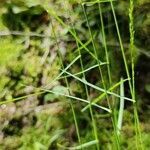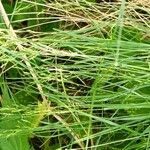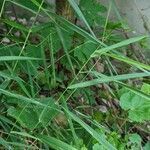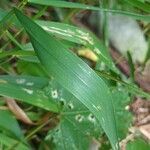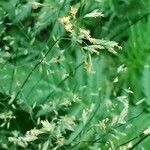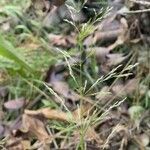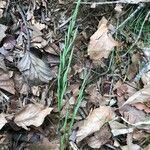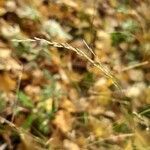Culms slender, tufted, 4–8 dm, without rhizomes; lvs lax, 1–2 mm wide, often divergent, often some of them above the middle of the shoot, the upper scarcely shorter than the lower; ligule truncate, 0.5 mm; infl narrowly ovoid, 1–2 dm, eventually loose and open, the slender branches in sets of ca 5, bearing spikelets in the distal half; spikelets 2–4-fld; glumes narrowly lanceolate, long-acuminate, the first 2.2–3 mm, conspicuously narrower than but nearly equaling the first lemma, the second 2.3–3.3 mm; lemmas apparently 3-veined (the intermediate veins obscure), 2.1–3.1 mm, webbed at base, the straight keel and marginal veins sericeous or villosulous below; glabrous or scabrous in the distal third; rachilla evidently puberulent at 30×; anthers 1.2–1.6 mm; 2n=28–70. Native of Europe, intr. across the continent in s. Can., and occasionally found in moist meadows and along roadsides throughout most of our range.
Culms loosely tufted, 30–80(–100) cm tall, erect or lightly geniculate, nodes 3–5(–6), uppermost at or above 1/2 way up. Leaf sheaths smooth or scabrid, shorter than blade; blade flat, soft, 5–12 cm × 1–3 mm, margins and both surfaces scabrid; ligule 0.2–1(–1.5) mm, truncate to obtuse. Panicle slender, 5–15(–22) cm, branches spreading, 2–5 per node, basal primary branch 1/2–2/3 as long as panicle with spikelets in distal 1/2. Spikelets lanceolate, 3.5–5(–6) mm, florets mostly 3; rachilla pilose; glumes narrowly lanceolate, 2.5–3.7 mm; lemma oblong-lanceolate, 2.5–3.7(–4.2) mm, keel shortly villous for 1/2 of length, marginal veins to 1/3, apex membranous; callus sparsely webbed, rarely glabrous; palea smooth and glabrous between keels. Anthers 1.3–1.5 mm. Fl. May–Jun. 2n = 14, 35, 70.
